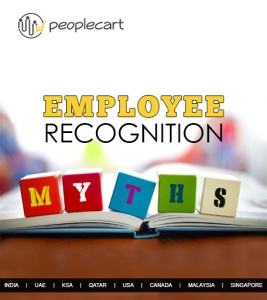28 Mar

Recognition at the workplace motivates employees and boosts their productivity. They are more likely to drive improvements and deliver on KPI’s if their efforts are valued and their contributions are appreciated. Studies have revealed that 64% of the employees resign as they feel unappreciated and disengaged while 69% of employees would work harder if they felt their efforts were better appreciated. Why is this happening?
Perhaps, the major cause for the hindrance is that organizations are still struggling to adopt modern recognition practices as part of their “Total Rewards Strategy”.
Let’s look at some common Myths and how reality defies the mythical logic:
Myth 1: Money matters
Tangible rewards with a direct financial value are important for employees; however, they are not memorable for them. Intangible rewards like well-deserved recognition, result in a memorable moment for the employee and hence is more significant than a cash reward.
The Reality:According to a study by McKinsey titled “Getting beyond Money”, praise and commendation from managers was rated the top motivator for performance, beating out other financial incentives, by a majority of workers which is 67%.
Myth 2: Recognition and appreciation are time consuming tasks
To acknowledge an employee’s efforts or a job done well and appreciating him in routine work takes time and energy, but it may not be more than few seconds or few minutes. For instance, even a small compliment given by a manager to his reportee while passing by, is more appreciated. Studies have revealed that receiving recognition increases an employee’s willingness to put more efforts and also improves giver’s stance.
The Reality: “Psychometrics which published “A Study of Employee Engagement in the Canadian Workplace”, states that when employees were asked about what leaders could do more of to improve engagement at the workplace, 58% of respondents replied “Give recognition.”
Myth 3: Appreciation from C-Level is favoured
Well, studies have shown that one-fourth of the employees prefer to be acknowledged and appreciated by their C-level management. While this is important, recognition coming from peers can be a potent engagement source. Appreciation received from co-workers brings about the positive change in an employee’s attitude which is reflected in his behaviours and customer addressing.
The Reality: The Globoforce Spring 2014 Workforce Mood Tracker survey shows that 73% employees prefer recognition coming from senior managers and peers both, whereas only 27% employees are happy with inputs coming from managers alone.
Myth 4: Appreciation is a soft skill with no measurable business metrics.
When tied to company values and strategic objectives, recognition and appreciation show employees how their efforts are contributing to team and company success. An assimilation of behavioural measurement and alignment with organizational values presents relevant metrics connecting the impact to business.
The Reality: According to a Towers Watson study, a 15% increase in employee engagement through tools like recognition leads to a 2% increase in profit margin.
Myth 5: Recognition is expensive and offers little ROI
Recognition done in a correct manner is free of cost. It takes few seconds to pause and appreciate your employees. Investing in recognition programs that are tied to corporate’s objectives and strategies increase the employee engagement. This lets employees to realise how their efforts are being appreciated by the corporate and fetch better results for the corporate.
The Reality: The SHRM/Globoforce Employee Recognition Survey, 2012 reveals that when companies spend 1% or more of payroll on recognition, 85% see a positive impact on engagement.



